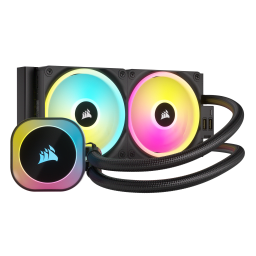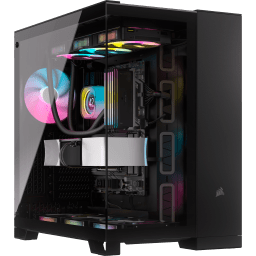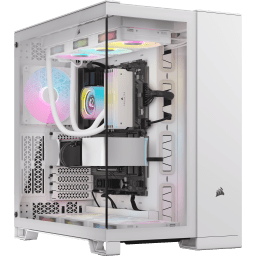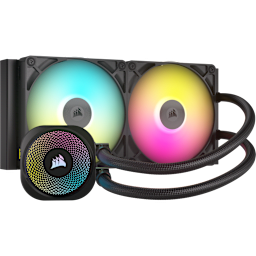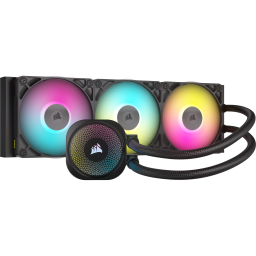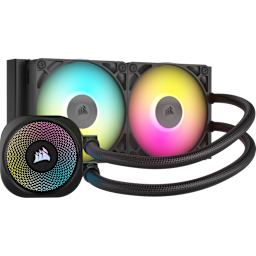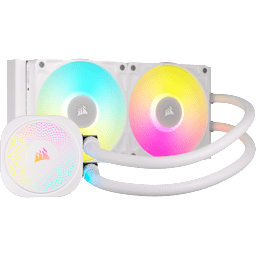인텔은 수십 년 동안 OEM(주문자 상표 부착 생산업체) 및 주류 PC 소비자를 위한 CPU(중앙 처리 장치)를 제조하는 데 있어 세계적으로 유명한 브랜드입니다. 수년 동안 인텔은 성능, 안정성, 다양한 소프트웨어 및 하드웨어 플랫폼과의 호환성으로 잘 알려진 CPU를 꾸준히 생산해 왔습니다.

과거에 데스크톱 PC를 구축한 적이 있다면 인텔과 AMD CPU를 모두 살펴보고 어떤 옵션이 가장 적합한지 확인해 보셨을 것입니다. 인텔이나 AMD 중 어느 쪽을 선택하든, 결국에는 선택한 CPU가 요구 사항을 충족하고 예산에 맞는다면 어느 쪽이든 잘못될 수 없습니다.
프로세서 시장에 들어가면 양쪽의 다양한 모델을 접하게 될 것입니다. 하지만 블루 팀(인텔)에 더 가깝다고 가정해 보겠습니다. 과거에는 프로세서 옵션의 일부가 아니었기 때문에 처음에는 약간 혼란스러울 수 있습니다. 하지만 걱정하지 마세요. 인텔 프로세서 접미사 뒤에 숨겨진 수수께끼를 풀 수 있도록 인텔의 K, KS, KF 및 F 프로세서의 차이점을 설명하는 가이드를 준비했으니 참고하시기 바랍니다.
인텔 K 대 KS 대 KF 대 F: 차이점은 무엇인가요?
빌드에 적합한 CPU를 선택할 수 있도록 인텔 F, K, KS, KF 프로세서를 살펴보고 차이점을 알아보세요.
인텔 K 프로세서
가장 인기 있는 인텔 프로세서 라인인 K 시리즈부터 시작하겠습니다. CPU의 표준 속도를 넘어 성능의 한계를 뛰어넘는 것을 즐기는 PC 마니아라면 K 시리즈가 이상적인 선택일 것입니다. 인텔 칩의 "K" 접미사는 언락된 제품임을 의미하며, 이는 CPU를 오버클럭하여 프로세서의 잠재력을 극대화할 수 있음을 의미합니다. 하지만 이 기능을 잠금 해제하려면 오버클럭된 CPU를 지원할 수 있는 마더보드와 함께 CPU에서 발생하는 열을 효과적으로 방출할 수 있는 고성능 액체 쿨러(예: CORSAIR 올인원 액체 CPU 쿨러)가 필요하다는 점을 명심해야 합니다. 구식 쿨러를 원하신다면 A115 공랭 쿨러를 선택하실 수도 있습니다.
CPU를 오버클럭하려면 기본 속도를 넘어설 때 CPU가 어떻게 작동하는지에 대한 깊은 이해가 필요합니다. 안정적인 오버클럭을 위해 CPU와 마더보드 매개변수를 모두 조정해야 하므로 마더보드의 BIOS 설정에 익숙해야 합니다. CPU를 오버클럭할 생각이 없다면 K 시리즈가 아닌 프로세서를 선택하는 것이 가장 좋습니다. 기본 주파수에서 K 시리즈 칩을 사용하면 승수가 잠금 해제된 CPU를 사용하는 모든 목적이 무효화됩니다.
또한 K 시리즈 CPU에는 통합 그래픽 또는 iGPU가 탑재되어 있어 CPU에 그래픽 처리 장치가 직접 내장되어 있다는 점도 주목할 필요가 있습니다. 다시 말해, NVIDIA, AMD 및 기타 타사 GPU 제조업체에서 생산하는 전용 그래픽 카드와 달리 CPU 자체에 내장된 그래픽 솔루션입니다.

인텔 KS 프로세서
KS 시리즈 프로세서는 더 높은 주파수와 더 높은 TDP를 제외하면 K 시리즈 프로세서와 거의 동일합니다. 하지만 이 시리즈는 인텔 코어 i9 프로세서로 제한되며 생산량이 더 제한되어 있기 때문에 더 많은 예산이 필요합니다.
이 시리즈는 시중에서 가장 빠른 프로세서로 성능을 극대화하려는 사용자를 위해 설계되었습니다. 게임, 스트리밍, 콘텐츠 제작, 비디오 편집 등 어떤 용도로 사용하든 KS 프로세서의 성능은 인텔 프로세서 중에서도 타의 추종을 불허합니다. 이 프로세서는 더 높은 주파수에서 실행되도록 인텔에서 사전 조정되었기 때문에 오버클러킹 애호가들에게도 특히 매력적인 시리즈입니다. 하지만 최고 수준의 성능에 대한 프리미엄을 지불해야 하므로 가치 제안이 자신에게 적합한지 여부를 염두에 두어야 합니다.
인텔 KF 프로세서
KF 시리즈 프로세서는 통합 그래픽이 없다는 점만 다를 뿐 본질적으로 K 프로세서와 동일합니다. 따라서 오버클러킹을 위한 훌륭한 옵션이며, K 프로세서보다 가격이 저렴합니다. PC 게이머와 마니아들 사이에서 흔히 볼 수 있는 전용 그래픽 카드를 시스템에 사용할 계획이라면 KF 시리즈가 탁월한 선택입니다. KF 시리즈를 선택하면 비용을 절약하고 그 여분의 현금으로 PSU 및 DRAM과 같은 고품질 PC 하드웨어에 투자할 수 있습니다.
사용 사례 측면에서 KF 프로세서는 K 시리즈 CPU가 처리할 수 있는 것 이상을 처리할 수 있습니다. 게임, 스트리밍, 콘텐츠 제작부터 비디오 편집까지, 고성능 그래픽 카드(GPU)와 함께 사용한다면 모두 KF CPU의 성능을 충분히 발휘할 수 있습니다. KF 프로세서는 전용 그래픽 카드를 사용하고 통합 그래픽이 필요하지 않거나 원하지 않는 사용자에게 보다 실용적인 CPU 솔루션입니다.
인텔 F 프로세서
인텔 K 및 KF 시리즈 프로세서와 마찬가지로 F 시리즈 칩도 메인스트림 데스크톱 프로세서로 간주됩니다. F 시리즈가 K 및 KF와 다른 점은 CPU의 배율이 고정되어 있어 기본 주파수 또는 광고된 속도를 초과하여 프로세서를 실행할 수 없다는 것입니다. 즉, F 시리즈 프로세서는 다른 두 프로세서처럼 오버클럭을 위해 설계되지 않았습니다. 잠긴 배율 외에도 F 시리즈에는 KF 시리즈와 같은 통합 그래픽이 없습니다.
F 시리즈 프로세서는 iGPU가 없고 멀티플라이어가 잠겨 있지만 장점이 있습니다. 예산이 부족한 PC 빌더에게는 훌륭한 옵션입니다. 요즘에는 PC를 만드는 비용이 저렴하지 않기 때문에 CPU에 지출하는 비용을 줄이는 것이 도움이 될 것입니다. 이를 통해 중급에서 최상급 GPU에 더 효과적으로 투자할 수 있습니다. 또 다른 장점은 F 시리즈에는 내장 그래픽이 없기 때문에 내장 그래픽이 있는 제품에 비해 열 출력이 더 관리하기 쉽다는 것입니다. 이는 이미 전용 GPU 솔루션이 있는 시스템의 에너지 효율성에 도움이 될 수 있습니다.
요약
- "K" 접미사가 붙은 인텔 프로세서는 CPU를 기본 주파수 이상으로 오버클럭할 수 있고 그래픽 또는 iGPU가 내장되어 있어 비디오 출력을 제공하기 위해 시스템에 전용 그래픽 카드가 반드시 필요하지 않음을 나타냅니다.
- 최상위 "KS" 시리즈 프로세서는 "K" 시리즈 프로세서의 슈퍼차지 버전으로, 가격 대비 성능을 원하는 사용자를 위해 설계되었습니다.
- "KF" 시리즈 프로세서는 코어 아키텍처가 동일하고 승수가 잠금 해제되어 있기 때문에 원시 처리 능력 및 성능 면에서 "K" 버전과 매우 유사합니다. 두 시리즈의 유일한 차이점은 K 시리즈의 통합 그래픽으로, KF 시리즈의 가격이 약간 더 저렴합니다. KF 시리즈에서는 비디오 출력을 위해 시스템에 전용 GPU가 있어야 합니다.
- "F" 시리즈의 경우 기술적으로는 "KF" 칩(iGPU 없음)과 동일하지만 배율이 잠겨 있어 CPU를 오버클럭할 수 없습니다. 그리고 KF 시리즈와 마찬가지로 비디오 출력을 위해서는 PC 빌드에 전용 그래픽 카드가 필요합니다.

인텔 애로우 레이크 코어 울트라 시리즈는 어떤가요?
또한 인텔의 최신 데스크톱 CPU인 인텔의 Arrow Lake Core Ultra 200 시리즈 CPU에는 새로운 명명 규칙이 적용되었지만 K, KF 등의 접미사는 동일하게 유지된다는 점도 주목할 필요가 있습니다.
최종 생각
인텔 프로세서를 고려할 때는 자신의 요구 사항과 사용 가능한 옵션 간의 차이점을 이해하는 것이 중요합니다. 지출할 수 있는 금액과 시간이 지남에 따라 프로세서의 가치를 고려하세요. 게임용 장비 없이도 기본적인 컴퓨터 작업을 처리할 수 있는 예산 친화적인 옵션을 찾고 있다면 F 시리즈가 좋은 선택입니다. 이 프로세서에는 GPU가 통합되어 있으며, i5 버전은 더 나은 성능을 제공합니다. 예산이 빠듯한 분들을 위해 i3 버전도 있습니다. 따라서 구매하기 전에 요구 사항과 예산을 고려하여 현명한 결정을 내리세요.
나만의 PC를 조립하는 중이라면 올바른 부품을 선택하는 데 도움이 되는 사용자 친화적인 온라인 도구가 많이 있다는 것을 기억하세요. 커세어 PC 빌더는 이 과정을 쉽고 간단하게 만들어주는 도구입니다. 하드웨어 호환성, 단계별 지침 및 부품 장착에 대한 정보를 제공하며, 모든 커세어 부품은 물론 다른 제조업체의 부품에 대한 사양을 포함하는 포괄적인 데이터베이스에 포함되어 있습니다.
마더보드, CPU, GPU를 선택했다면 그 외의 모든 제품은 CORSAIR에서 구매할 수 있습니다. 케이스, RAM, 키보드, 헤드셋 등. 커세어는 모든 제품을 생산하고 있으며 메인 웹사이트를 둘러보며 곧 있을 업그레이드를 마무리할 수 있습니다.
기사 내 제품
